Introduction: The German Vedutista
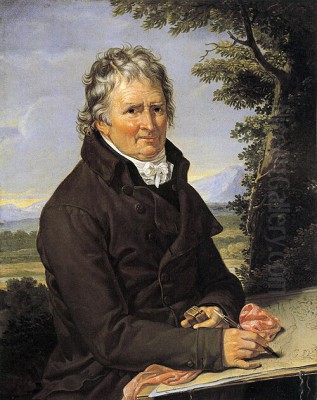
Jacob Philipp Hackert stands as one of the most significant German painters of the late 18th century, renowned primarily for his mastery of landscape painting. Born in Prenzlau, in the Uckermark region of Brandenburg, Prussia, in 1737, Hackert navigated the transition from late Baroque sensibilities towards the burgeoning ideals of Neoclassicism and early Romanticism. His career, largely spent outside his homeland, particularly in Italy, cemented his reputation across Europe as a leading vedutista – a painter of detailed, often large-scale topographical views. His meticulous attention to detail, combined with an idealized, harmonious vision of nature and classical antiquity, earned him prestigious commissions and the admiration of influential figures like Johann Wolfgang von Goethe. Hackert passed away near Florence in 1807, leaving behind a substantial body of work that continues to be studied for its technical brilliance and its reflection of Enlightenment-era aesthetics.
Early Life and Artistic Formation
Jacob Philipp Hackert hailed from a family where artistic pursuits were common. His father, Philipp Hackert, was primarily a portrait painter and likely provided his son with initial instruction. The artistic environment extended to his siblings; several of his brothers also became artists, most notably Johann Gottlieb Hackert, who often collaborated with Jacob Philipp, and George Abraham Hackert, who later played a role in disseminating his brother's work through engravings. This familial foundation provided a supportive context for his burgeoning talent.
Seeking formal training, Hackert enrolled at the Academy of Fine Arts in Berlin (Akademie der Künste). There, he studied between approximately 1755 and 1757. A key figure during his formative years at the Academy was the French-born director, Blaise Nicolas Le Sueur, who encouraged Hackert's inclination towards landscape painting. During this period, Hackert honed his technical skills, focusing on drawing and the principles of composition. He diligently studied and copied the works of established masters, particularly the idealized landscapes of the 17th-century French painter Claude Lorrain and the detailed scenes of the Dutch Golden Age painter Philips Wouwerman (often noted for his depictions of horses and battles within landscapes). This grounding in established traditions provided him with a strong technical base upon which he would build his distinctive style.
Travels and the Italian Magnet
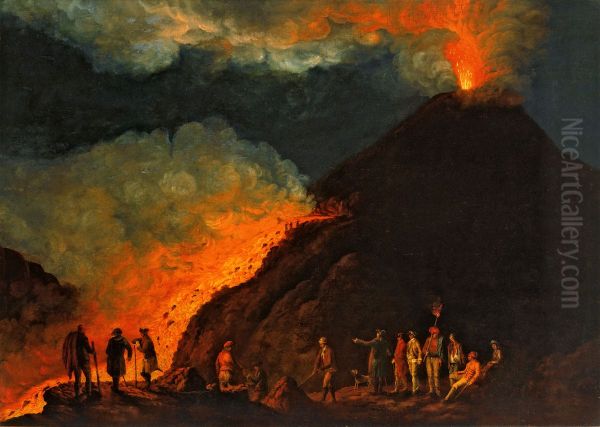
Like many artists of his era, travel was crucial to Hackert's development and career. His first significant journey abroad took him to Sweden in 1762. His talent quickly gained recognition, and by 1764, he had secured commissions from the Swedish court, producing a series of landscape paintings for the King. This early success likely bolstered his confidence and ambition.
In 1765, Hackert moved to Paris, a major artistic hub. There, he encountered the celebrated French landscape and marine painter Claude-Joseph Vernet. The two artists formed a friendship, and Vernet's style, known for its dramatic seascapes, atmospheric effects, and often idealized compositions, exerted a considerable influence on Hackert's subsequent work. This period in Paris exposed Hackert to the latest trends in French art and further refined his approach to landscape.
However, the ultimate destination for an ambitious landscape painter steeped in classical ideals was Italy. In 1768, Hackert embarked on the journey south, a move that would define the remainder of his career. He initially settled in Rome, the epicenter of the Grand Tour and a gathering place for artists, patrons, and intellectuals from across Europe. The city and its surrounding Campagna, rich with ancient ruins and picturesque scenery, provided inexhaustible subject matter.
The Neapolitan Court Painter
While Rome was foundational, Naples became the center of Hackert's most productive and prestigious period. He traveled extensively throughout southern Italy and Sicily, meticulously documenting the landscapes, coastal views, and archaeological sites. His reputation grew rapidly among the wealthy travelers on the Grand Tour and the local aristocracy.
A pivotal moment came when he attracted the patronage of King Ferdinand IV of Naples (also Ferdinand I of the Two Sicilies). Impressed by Hackert's skill and his ability to capture the beauty of his kingdom, Ferdinand appointed him Court Painter in 1786. This prestigious position provided Hackert with financial security, unparalleled access to royal sites, and numerous high-profile commissions. He was tasked with documenting the kingdom's landscapes, royal hunts, and important events, including naval maneuvers. His studio became a prominent fixture in the Neapolitan art scene.
During his time in Naples, Hackert worked closely with Sir William Hamilton, the British envoy to the Neapolitan court, a renowned antiquarian and volcanologist. Hackert produced drawings, possibly intended for engravings, depicting the volcanic landscapes of the Phlegraean Fields for Hamilton around 1770, although Goethe's later account sparked some discussion regarding the precise nature of Hackert's contribution versus other artists involved in Hamilton's publications.
Artistic Style: Precision and Poetry
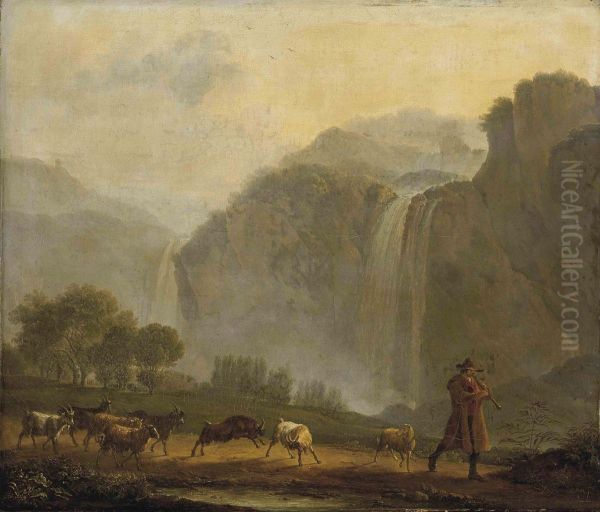
Hackert's art is characterized by a unique synthesis of objective observation and aesthetic idealization, firmly rooted in the principles of Neoclassicism but often imbued with a pre-Romantic sensibility.
Topographical Accuracy and Detail: A hallmark of Hackert's style is his commitment to topographical accuracy. He rendered geographical features – mountains, rivers, coastlines, specific types of trees, and rock formations – with remarkable precision. His works often served not just as artistic creations but also as valuable visual records of specific locations. This detailed realism appealed to Enlightenment patrons who valued empirical observation and scientific accuracy. He meticulously studied botany and geology to ensure the veracity of his depictions.
Idealized Composition and Light: Despite his focus on accuracy, Hackert did not merely transcribe reality. He carefully composed his scenes according to classical principles of harmony, balance, and order, often subtly rearranging elements to achieve a more perfect or picturesque effect. His handling of light is particularly noteworthy. He masterfully captured the clear, luminous light of the Italian sky, using subtle gradations of tone to define form and create a sense of depth and atmosphere. While often calm and serene, his works could also capture more dramatic effects, such as the glow of a volcanic eruption or the specific light of different times of day.
Influence of Claude Lorrain and Vernet: The influence of Claude Lorrain is evident in Hackert's idealized compositions, his use of framing elements like trees, and his often tranquil, pastoral mood. From Claude-Joseph Vernet, he absorbed techniques for depicting water, skies, and atmospheric effects, particularly visible in his coastal scenes and seascapes. Works like his views of Lake Nemi clearly show Vernet's impact in their handling of light and idyllic atmosphere.
Neoclassicism and Romantic Stirrings: Hackert worked squarely within the Neoclassical tradition, emphasizing clarity, order, and the depiction of classical antiquity. His paintings frequently feature ancient ruins integrated harmoniously into the landscape, evoking a sense of history and timelessness. However, his sensitivity to atmosphere, his detailed rendering of specific natural phenomena, and the occasional sublime subject (like views of Mount Vesuvius erupting) hint at the emerging Romantic fascination with the power and specificity of nature. He bridges the gap between the ordered world of Neoclassicism and the more emotive focus of Romanticism.
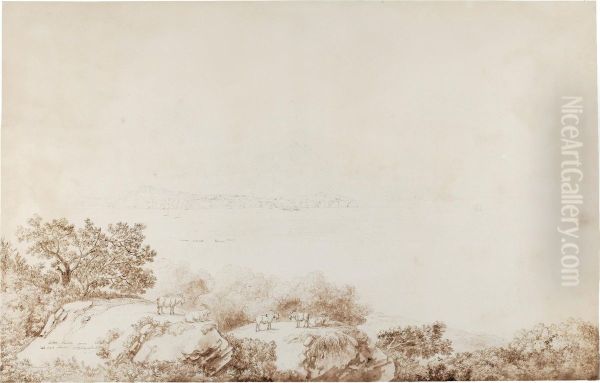
Technical Proficiency: Hackert was technically versatile, proficient in oil painting, gouache, and drawing (often using pen and ink with wash). His oil paintings are characterized by a smooth finish and careful layering of glazes to achieve luminosity. His drawings and gouaches often served as studies or finished works in their own right, showcasing his confident draftsmanship and keen observational skills. He also collaborated with engravers, including his brother George Abraham, to disseminate his compositions more widely.
Representative Works and Major Commissions
Hackert's prolific output includes numerous celebrated paintings, many commissioned by royalty and aristocracy.
The Harbor of Naples: Hackert painted several views of the bustling Bay of Naples, showcasing his skill in marine painting and topographical accuracy. These works capture the vibrant life of the port against the backdrop of Mount Vesuvius, demonstrating his ability to combine detailed observation with a grand, panoramic scope.
Landscape with the Temples at Segesta (1777): This work, depicting the remarkably preserved Doric temple in Sicily, exemplifies Hackert's engagement with classical antiquity. He places the ancient structure within a carefully rendered, specific landscape, highlighting the interplay between nature and history. This painting is now housed in the Galerie Scheidwimmer, Munich.
The Battle of Chesma (Series, 1770s): Commissioned by Count Alexei Orlov to commemorate the Russian naval victory over the Ottoman Empire, this series of large canvases required Hackert to meticulously research naval details and consult eyewitness accounts. Painted with the assistance of marine specialists and heavily influenced by Vernet's dramatic seascapes, the series cemented Hackert's international reputation. These paintings are primarily located in Russia, with key examples at the Central Naval Museum in St. Petersburg and Peterhof Palace. The snippets mention cooperation with Vernet on these, highlighting their close artistic relationship.
Villa d'Este at Tivoli (1792): Capturing the famous gardens and villa near Rome, this work showcases Hackert's ability to depict complex architectural elements within a lush, cultivated landscape. It reflects the Grand Tour fascination with Italian villas and gardens. This painting can be found in the Germanisches Nationalmuseum, Frankfurt.
Grape Harvest and View of Sorrento, the Gulf of Naples and the Islands (1784): This painting, located in the Wallraf-Richartz Museum, Cologne, combines genre elements (the grape harvest) with a sweeping panoramic view, typical of Hackert's Neapolitan period. It celebrates the fertility and beauty of the region under Bourbon rule.
View of Vicovaro from Horace's Villa (1780): Reflecting the interest in classical literature and sites associated with ancient authors, this work (housed in the Goethe Museum, Düsseldorf) demonstrates Hackert's ability to evoke historical associations through landscape.
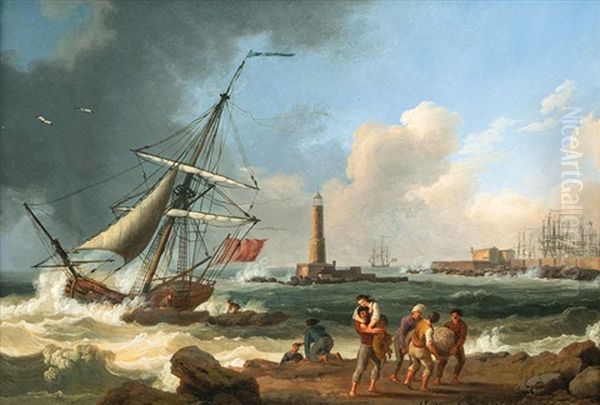
Eruption of Vesuvius (e.g., 1779): Hackert witnessed and depicted several eruptions of Mount Vesuvius. These paintings combine scientific observation with a sense of the sublime, capturing the dramatic power of nature. One such version from 1779 appeared in a private collection auction in 2023.
Other notable works mentioned in the provided context include Cajazzo Mountain, Landscape near Cava dei Tirreni (1778, Kunsthalle Bremerhaven), Temple of Hercules at Cori near Velletri (1783, Museo di Capodimonte, Naples), Cotton Harvest (1787, Musei Capitolini, Rome), and late works like Ziege am Bach (1804) and Alter Olivenbaum am Camaldoli (1805), both noted as being in Berlin private collections.
Relationships, Influence, and Legacy
Hackert's career was interwoven with connections to patrons, fellow artists, and intellectuals.
Mentors and Influences: Beyond his father Philipp Hackert and his Berlin teacher Blaise Nicolas Le Sueur, the key influences were Claude Lorrain, Philips Wouwerman, and especially Claude-Joseph Vernet. The provided snippets also mention Johann Georg Leers as a teacher, though Le Sueur is more prominently cited in relation to his Academy directorship. Hackert absorbed lessons from these predecessors, integrating their approaches into his own distinct vision.
Contemporaries and Collaborators: His friendship with Vernet in Paris was formative. In Italy, he moved within circles that included other prominent artists working in Rome and Naples, such as the Swiss painter Angelica Kauffman and the German Neoclassical giant Anton Raphael Mengs, though direct collaborations beyond his brother Johann Gottlieb Hackert are less documented than mutual influence and shared patronage circles. His relationship with Sir William Hamilton was significant, placing him at the intersection of art, antiquarianism, and science. He also formed a friendship with the visiting British watercolourist John Robert Cozens, whose atmospheric, often melancholic landscapes shared some affinities with Hackert's sensitivity to light and place, despite their stylistic differences.
Goethe's Admiration: A particularly important relationship was with Johann Wolfgang von Goethe. The great German writer met Hackert in Italy in 1787 and deeply admired his work and his methodical approach to art. Goethe saw Hackert as embodying an ideal fusion of artistic talent and scientific observation. He praised Hackert's ability to represent nature truthfully yet poetically. After the artist's death, Goethe wrote a biographical essay on Hackert (published in 1811), which remains a primary source of information and significantly shaped Hackert's posthumous reputation. Goethe's high praise, calling him an outstanding painter of landscapes, marines, and hunts, underscored Hackert's versatility and status.
Students and Followers: Hackert's influence extended through his students and followers. His brother, George Abraham Hackert, helped popularize his work through engravings. Other artists who studied with him or were significantly influenced by his style included Christopher Kniep (who accompanied Goethe on his Sicilian journey), the Austrian painter Michael Wutki (known for his dramatic depictions of Vesuvius), and Italian artists like Vincenzo Aloja and the engraver Salvatore. Through these figures and the widespread dissemination of his works via prints, Hackert's style impacted landscape painting in Germany and Italy well into the 19th century. Figures like Joseph Anton Koch show a lineage tracing back to the kind of heroic, detailed landscape Hackert championed.
Competition and Market Success: Hackert operated in a competitive art market, particularly in Rome and Naples, where numerous artists vied for the patronage of Grand Tourists and local nobility. His success stemmed from his technical skill, his reliability in fulfilling commissions, and his style that perfectly matched the tastes of the era – a blend of topographical accuracy, classical allusion, and picturesque beauty. His ability to secure and maintain royal patronage set him apart from many contemporaries.
Anecdotes and Later Life
Hackert's life was not without points of discussion. The aforementioned ambiguity surrounding his exact contribution to Sir William Hamilton's Phlegraean Fields publications, as recounted by Goethe, represents a minor historical debate. Similarly, mentions by figures like Lorenzo Giustiniani regarding Hackert's role in Neapolitan printing history point to his integration into the cultural fabric of the city, even if the specifics are debated.
The political turmoil of the late 1790s disrupted Hackert's comfortable position in Naples. The French invasion and the establishment of the Parthenopean Republic in 1799 forced him to flee. He eventually settled in Tuscany, purchasing a property near Florence in San Pietro di Careggi. He continued to paint in his later years, focusing on Tuscan landscapes and sometimes revisiting earlier themes, as seen in the late works depicting olive trees or animals in landscapes.
His reputation remained high during his lifetime, making him one of the most famous and financially successful German artists of his generation. However, with the rise of Romanticism and subsequent shifts in artistic taste during the 19th century, his meticulously detailed and somewhat objective style fell out of favor compared to more overtly emotional or atmospheric landscape painters like Caspar David Friedrich or J.M.W. Turner. His work was sometimes criticized as overly dry or lacking in profound feeling.
In the 20th and 21st centuries, there has been a significant reassessment of Hackert's work. Art historians now recognize his crucial role in the development of Neoclassical landscape painting, his technical virtuosity, and his importance as a visual chronicler of late 18th-century Italy. Major exhibitions and scholarly publications have shed new light on his career, restoring his status as a major figure in European art history. His works are now prized possessions in numerous international museums and private collections.
Conclusion: Bridging Observation and Ideal
Jacob Philipp Hackert carved a unique path in 18th-century European art. As a German artist who found his greatest success in Italy, he became a leading exponent of Neoclassical landscape painting. His work is defined by an extraordinary commitment to topographical accuracy and detailed observation, reflecting the empirical spirit of the Enlightenment. Yet, he masterfully combined this realism with the classical ideals of harmony, order, and idealized beauty, learned from masters like Claude Lorrain and refined through his association with contemporaries like Claude-Joseph Vernet.
Serving patrons from the Swedish King to the King of Naples and Catherine the Great's court (via Count Orlov), and admired by intellectuals like Goethe, Hackert achieved remarkable contemporary fame. His paintings of Italian landscapes, ancient ruins, bustling harbors, and dramatic natural events like the eruptions of Vesuvius, captured the imagination of the Grand Tour generation. While his reputation fluctuated after his death, his significance is now undisputed. He stands as a crucial link between the veduta tradition, the ideals of Neoclassicism, and the burgeoning interest in the specific character of landscape that would blossom fully in Romanticism. His meticulous technique, his luminous depiction of light, and his ability to invest precise observation with poetic harmony ensure his enduring importance in the history of art.